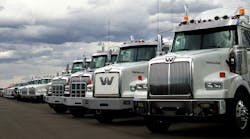Some time ago, I warned about the danger of trusting parts that come in a plain white box. I cautioned fleets that the cost savings associated with untraceable and untested components often result in a false sense of security and increased liability. There may be times when an “off-brand” or “knock-off” may be good enough, but when it comes to the operation of a truck (with or without the trailer), it can have serious consequences.
During the recently held Annual Meeting and Exhibition for the Technology and Maintenance Council (TMC) of the American Trucking Assns., an exhibitor who I've known for years decided to conduct a little experiment. He stopped by four truck parts suppliers in the greater Tampa area and purchased standard 33-mm flange nuts for a hub-piloted wheel. As luck would have it, each supplier carried a different “brand,” so he ended up with four different brands of fasteners, some of which came in a plain white box.
The first flange nut was from a well-known manufacturer, and all of the markings were clearly stamped on the fastener. We'll call that one flange nut A. Flange nut B was from a notable supplier, and the markings were also clearly stamped on the fastener. On the other hand, the manufacturer of flange nut C was identifiable, but the markings could hardly be considered clear. Finally, flange nut D was the typical unmarked and untraceable fastener that you might buy out of the back of someone's van.
All of the fasteners were checked on a Skidmore-Wilhelm gauge so the bolt tension (or clamping force) could be measured at 500 lbs.-ft. of torque. As expected, flange nut A performed admirably with consistent results that were in the middle of the desired range for a hub-piloted wheel. Each sample was more or less on the money with minimal variation. While I wouldn't classify it as empirical evidence, it definitely supported the theory that name-brand parts deliver name-brand performance.
Unfortunately, the consistency ended after the remaining flange nuts were tested. Flange nuts B and C were identifiable and appeared to be of high quality, but the Skidmore gauge showed otherwise, with up to a 50% loss of bolt tension at 500 lbs.-ft. Some of the readings were in the neighborhood of the minimum values, but none of the samples could be labeled consistent at the recommended torque. And it's also important to note that the best examples were still on the low end of the desired range in clamping force. Flange nut D performed no better, but everyone expected it to fall short based on the lack of markings.
As someone with experience in a courtroom, I will not release the names of the fasteners nor the places where they were purchased. Nor will I provide any information regarding the clamping force values. TMC has already formed a Task Force to look into the matter so as soon as we have more concrete data, I will be happy to share it with the industry.
In the meantime, I am once again warning fleets to be very careful about the parts that they choose. When times are tough like they are right now, the temptation to save a few dollars with the plain white box is greater than ever. But the impromptu test that I witnessed sent shivers down my spine. Fleets can try to do the right thing by replacing worn-out flange nuts and in the process create a wheel-off situation — even when the proper torque is used to tighten the fastener.
Kevin Rohlwing can be reached at [email protected]


